Alpaca Fiber Market Research, 2031
The global alpaca fiber market was valued at $846.5 million in 2021, and is projected to reach $1.2 billion by 2031, growing at a CAGR of 3.5% from 2022 to 2031.Alpaca fiber is a natural, renewable, and biodegradable substance derived from the fleece of the South American alpaca, a domesticated member of the camel family. Alpaca fibers are popular in the creation of high-end garments, blankets, and accessories due to their softness, warmth, and durability. Alpaca fibers come in a variety of natural colors, ranging from white to black, and can also be dyed to create a wide spectrum of shades. Alpaca fiber is regarded as a premium material and is highly prized by people seeking eco-friendly, sustainable, and high-quality items.
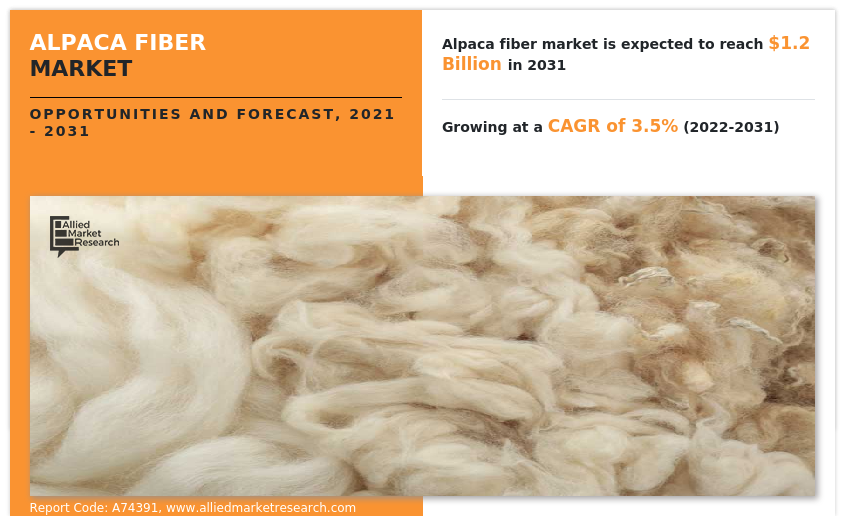
The increasing demand for sustainable and eco-friendly textile goods is driving the alpaca fiber market. Customers are becoming more concerned of the environmental effect of their purchases and are seeking products manufactured from natural and renewable materials. Alpaca fiber is a biodegradable and environmentally beneficial alternative to synthetic fibers. Alpaca fiber is also popular among consumers because of its smooth and sumptuous feel. The demand for sustainable and eco-friendly textiles is predicted to increase in the future years. Alpaca fiber is anticipated to grow even more popular as the fashion industry becomes more environmentally conscious.
The high cost of production is one of the major challenges for the alpaca fiber market. Alpacas require special care and upkeep, and their fibers must be gathered and handled with care. This can raise production costs, making alpaca fiber goods more expensive than synthetic alternatives which are going to hamper the growth of the alpaca fiber market share.
Development of new goods and uses is another opportunity for the alpaca fiber market. Alpaca fibers are versatile and may be utilized in a wide range of things, from clothes to home decor to automobile interiors. There is an opportunity to create and produce new products that take advantage of alpaca fibers particular features, such as softness, warmth, and durability. This could open up new markets and help to boost industrial growth. Also, there is a chance to engage in R&D to improve the quality and consistency of alpaca fibers. This could include advancements in breeding, shearing, and processing methods to produce fibers that are more uniform and of higher quality. This could help to raise the value of alpaca fibers and make them more competitive in the global alpaca fiber market growth.
The key players profiled in alpaca fiber market forecast report include AHA Bolivia, The Alpaca Yarn Company, The Natural Fiber Company, Zeilinger Wool Co., Altifibers S.A., Alpaca Owners, Association, Inc., Plymouth Yarn Company, Inc., Mary Maxim Inc., Berroco, Inc., and Stichting Agriterra.
The global alpaca fiber market is segmented on the basis of type, application, grade, and region. By type the market is divided into Huacaya fiber and Suri fiber. By Application, the market is divided into flooring, textile, industrial felting, and others. By grade the market is divided into ultrafine, superfine, fine, medium, and intermediate. By region, the market is analyzed across North America, Europe, Asia-Pacific, and LAMEA.
The alpaca fiber market is segmented into Application, Type and Grade.
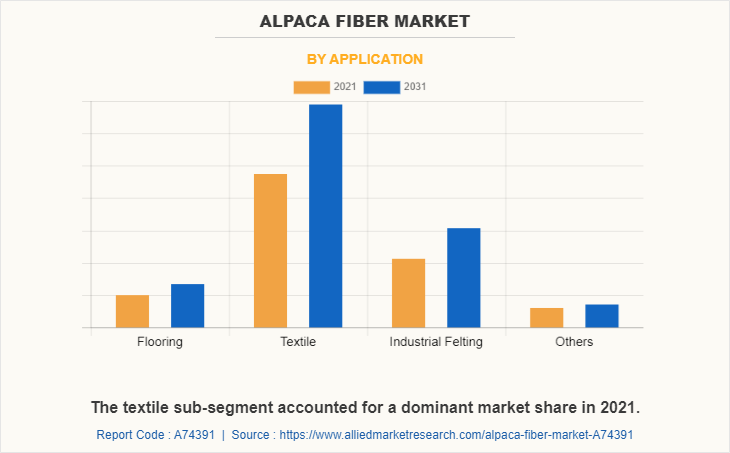
By application, the textile sub-segment accounted for a dominant market share in 2021. Alpaca fiber is highly valued for its unique qualities such as softness, warmth, and durability, making it a popular choice for a wide range of textile products. Clothing, household textiles, and accessories comprise the textile sub-segment. Alpaca fiber is used in all of these applications, and its popularity is growing as a result of rising customer demand for environmentally friendly and sustainable products. Alpaca fiber is appealing to ecologically conscious customers because it is natural, renewable, and biodegradable.
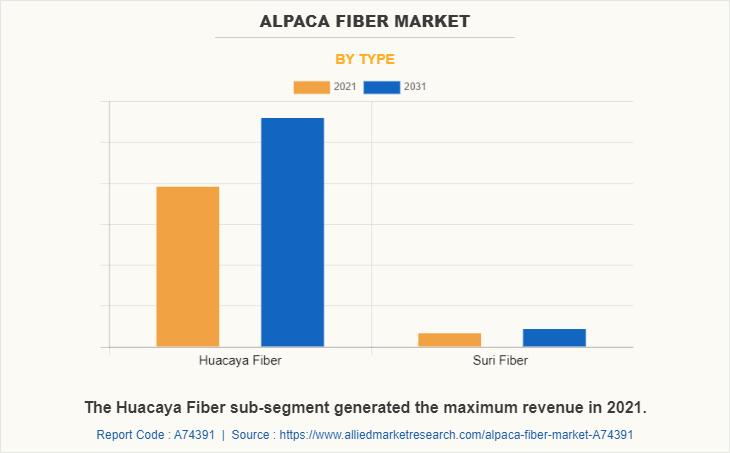
By type, the huacaya fiber sub-segment accounted for a dominant market share in 2021. Huacaya fibers are the most prevalent type of alpaca fiber, accounting for roughly 90% of the global alpaca herd. These fibers are highly valued in the textile industry for their softness, crimp, and insulation qualities. In addition, huacaya fibers are less difficult to process and can be spun into a broader variety of products than Suri fibers. Also, demand for Huacaya fibers is rising as alpaca products become more popular. These are predicted to be the major factors fueling the alpaca fiber market size.
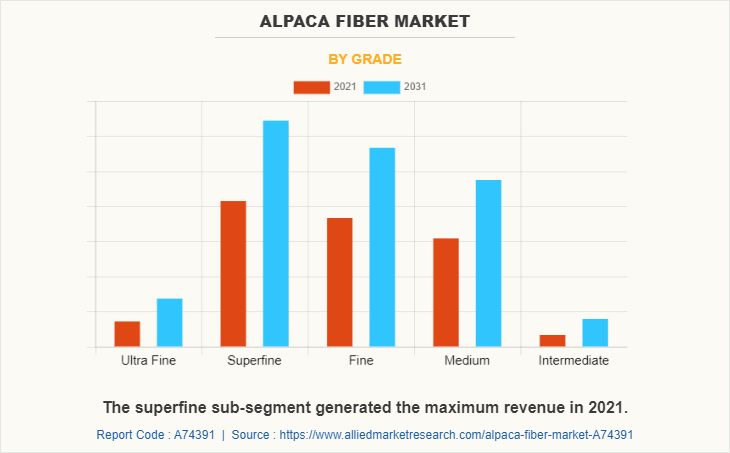
By grade, the superfine sub-segment accounted for a dominant market share in 2021. Superfine alpaca fiber is highly valued for its softness, fineness, and absence of guard hair, making it perfect for use in high-end textiles and apparel. The finest and softest fibers from an alpaca's shearing, usually less than 18.5 microns in diameter, are used to make superfine alpaca fiber. This fiber has a luxurious feel and is extremely comfortable, making it a popular option for high-end clothing and accessories. In addition, superfine alpaca fiber has excellent thermal properties, making it an excellent insulator in cold conditions.
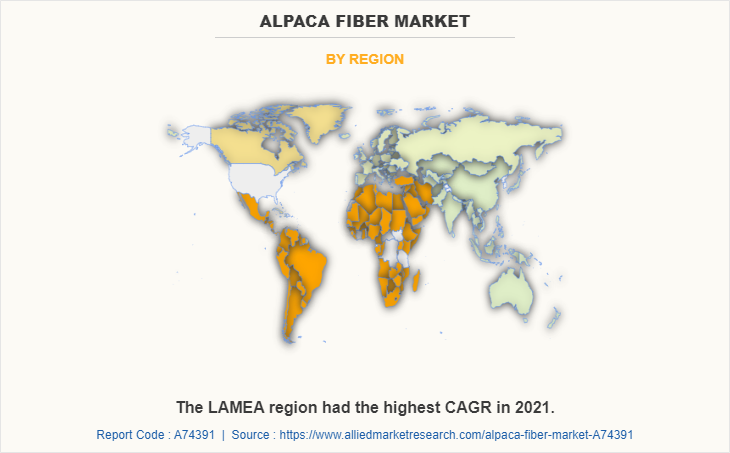
By region, LAMEA region generated the maximum revenue in 2021. The region's rich cultural heritage and long history of alpaca farming provide a strong foundation for the growth of the market. In Latin America, countries such as Peru, Chile, and Bolivia are major players in the alpaca fiber market. These countries are known for their high-quality alpaca fiber products, which are in demand in international markets. The region's vast natural resources and favorable climatic conditions for alpaca farming make it an attractive destination for investors in the alpaca fiber industry.
Impact of COVID-19 on the Global Alpaca Fiber Industry
- The lockdowns and restrictions imposed by governments to control the spread of the virus led to a decline in consumer spending on luxury items, including alpaca fiber products. This resulted in reduced demand and revenue for businesses operating in the alpaca fiber industry.
- The COVID-19 pandemic has brought several uncertainties leading to severe economic losses as various businesses across the world were on a standstill. This has ultimately lowered the demand for alpaca fibers due to the closure of fashion and textile industry due to COVID-19 pandemic restrictions.
- Additionally, border closures and limits on foreign travel caused a disturbance in the supply chains of alpaca fiber products. This caused delays and higher expenses in the manufacture and delivery of raw materials and final goods.
Key Benefits For Stakeholders
- This report provides a quantitative analysis of the market segments, current trends, estimations, and dynamics of the alpaca fiber market analysis from 2021 to 2031 to identify the prevailing alpaca fiber market opportunities.
- The market research is offered along with information related to key drivers, restraints, and opportunities.
- Porter's five forces analysis highlights the potency of buyers and suppliers to enable stakeholders make profit-oriented business decisions and strengthen their supplier-buyer network.
- In-depth analysis of the alpaca fiber market segmentation assists to determine the prevailing market opportunities.
- Major countries in each region are mapped according to their revenue contribution to the global market.
- Market player positioning facilitates benchmarking and provides a clear understanding of the present position of the market players.
- The report includes the analysis of the regional as well as global alpaca fiber market trends, key players, market segments, application areas, and market growth strategies.
Alpaca Fiber Market, by Type Report Highlights
| Aspects | Details |
| Market Size By 2031 | USD 1.2 billion |
| Growth Rate | CAGR of 3.5% |
| Forecast period | 2021 - 2031 |
| Report Pages | 280 |
| By Application |
|
| By Type |
|
| By Grade |
|
| By Region |
|
| Key Market Players | Zeilinger Wool Co., The Natural Fibre Company, Berroco, Inc., Altifibers S.A., Plymouth Yarn Company, Inc. , THE ALPACA YARN COMPANY, AHA Bolivia, Stichting Agriterra, Alpaca Owners Association, Inc., Mary Maxim Inc. |
Analyst Review
The global alpaca fiber market is expected to grow at a significant rate in the coming years. Alpaca fibers are highly valued for their softness, durability, and thermal properties. They are commonly used in the production of high-end clothing, blankets, and accessories. The market for alpaca fiber is mostly driven by the rising demand for environmentally friendly and sustainable goods. Customers are increasingly choosing goods manufactured from natural and renewable resources as they become more aware of the environmental impact of their purchases. Alpaca fibers are a desirable alternative for environmentally aware consumers because they are biodegradable and can be acquired sustainably. The main challenges facing the alpaca fiber market is the high cost of production. Alpacas require specialized care and maintenance, and their fibers must be carefully harvested and processed. This can drive up the cost of production, making alpaca fiber products more expensive than their synthetic counterparts. The development of novel sourcing and processing technologies is a growth opportunity in the alpaca fiber market. Innovations in breeding, shearing, and processing could help to reduce the cost of production and make alpaca fibers more widely available. All these factors are anticipated to boost the alpaca fiber market growth.
Among the analyzed regions, LAMEA is expected to account for the highest revenue in the market by the end of 2031, followed by Asia-Pacific, Europe, and North America.
Alpaca fiber is known for its softness, warmth, and durability, making it a popular choice for luxury and high-quality textiles. As the demand for luxury goods increases, the demand for alpaca fiber is also likely to grow, presenting a significant opportunity for market growth.
The major growth strategies adopted by alpaca fiber market players are investment and agreement.
LAMEA will provide more business opportunities for the global alpaca fiber market in future.
AHA Bolivia, THE ALPACA YARN COMPANY, The Natural Fibre Company, Zeilinger Wool Co., Altifibers S.A., Alpaca Owners, Association, Inc., Plymouth Yarn Company, Inc., Mary Maxim Inc., Berroco, Inc., and Stichting Agriterra are the major players in the alpaca fiber market.
The textile sub-segment of the application subsegment acquired the maximum share of the global alpaca fiber market in 2021.
Textile manufacturers, fashion designer, and retailers are the major customers in the global alpaca fiber market.
The report provides an extensive qualitative and quantitative analysis of the current trends and future estimations of the global alpaca fiber market from 2021 to 2031 to determine the prevailing opportunities.
Loading Table Of Content...
Loading Research Methodology...



